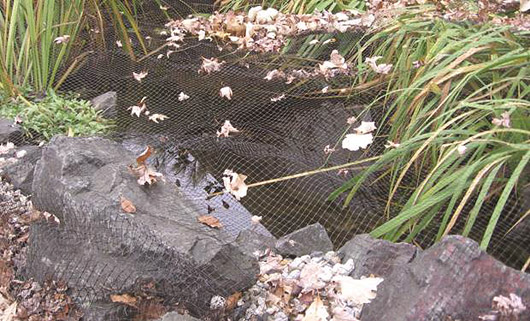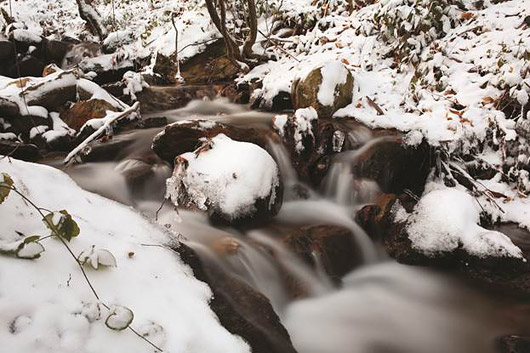Articles written by guest contributors

Covering ponds with netting saves a lot of work fishing out dead leaves in the spring.
5 steps to prep water for winter
By Dave Ouwinga, President EasyPro Pond ProductsThese steps can keep a pond, its equipment and its inhabitants safe all winter.
Step 1
Fall is an ideal time to clean a pond. If done while the fish are still active, they are not likely to suffer any ill effects and will have a healthier winter environment. Some experts recommend removing up to 50% of the water during the cleaning process by using a pump or a pond vacuum to remove water and debris from the bottom. If you do this, don’t forget to add the dechlorinator and chloramine remover when refilling.This is also an ideal time to remove and clean any equipment you won’t be using until spring. Ultraviolet lights should also be removed or insulated from the plummeting temperatures. Plants should be prepared or removed in preparation for colder months ahead.
Step 2
If there are trees near the pond, cover the pond with netting. This saves a lot of work down the road of fishing out dead leaves from the water. Use poles, inner tubes or other objects to keep the net above the water. If the net is on the water, it will sink into the water with the weight of the leaves and snow and be very difficult to work with. Another option is to build a dome over the pond. This can keep leaves and snow out, while retaining heat.Step 3
As the water temperature begins to drop, fish become less active. Begin feeding the fish a wheat germ-based food when the water temperature drops below 60°. This specialty diet aids in digestion. When the water temperature drops below 50°, stop feeding the fish, even on warm days during the winter, until water temperatures reach 50° again. While it may seem hard to believe, the fish don’t need food in the cold temperatures in order to survive, and feeding them when the water is below 50° can actually cause them harm.Step 4
There must be a hole in the ice maintained throughout the winter so that fish have enough oxygen to survive. Deadly gases, such as hydrogen sulfide gas, build up under the ice as the organic matter accumulated over the year decays and uses up available oxygen. If the pond should freeze over, don’t try to break a hole in the ice. The blows will cause shock waves to pass through the water causing damage to soft tissue of fish.Place a pot of boiling water on the ice and let it melt through. Tie a string or a rope onto the handle so you can retrieve the pot once it melts through. Other critters, such as tadpoles, frogs, turtles and snails, will take shelter in the area around the pond. Some will hide around water plants, in other safe places in the pond, or in the landscape near the pond. While these critters don’t need anything special from us to survive, do make sure that any critter you stock is winter-hardy. There are some tropical animals that can’t survive in the cold.
Step 5
Drain all water from any exterior piping, such as the autofill valve, to eliminate cracking or breaking from the eventual freezing. Check the water level often and add water as needed to replace any that has evaporated. If you add more than 1” of water, be sure and use a dechlorinator and chloramine remover at the rate specified. If the waterfall and stream features are left running during the winter, it’s important to visually inspect the pond water level to ensure that winter freezes and thaws have not created a water leak or redirected the flow of water somewhere other than back to the pond. Also, make sure to keep snow from piling up too high on the pond, too, because the snow blocks sunlight.Winterization checklist
- Clean the pond before winter sets in. This will remove debris that could harm fish and plants. Most experts don’t recommend more than a 50% water change when doing this, because you don’t want to kill all of the beneficial bacteria in the pond.
- Clean and store equipment. If the pond pumps are to be shut down, make sure all plumbing is drained and filters are disconnected and stored until next season.
- Remove or insulate all UV lights. These are expensive pieces of equipment and need to be protected. If the waterfall is going to be run during the winter, the UV can be removed and replaced with a piece of pipe to run the waterfall.
- Trim and remove plants. Trim plants that are winter hardy and remove anything that is tropical.
- Use cover netting. Put it over the pond to keep leaves and debris out and reduce the amount of sludge at the bottom of the pond in the spring.
- Keep a hole in the ice. This can be done with a heater, air stone or a running waterfall.
- Watch water levels regularly. You lose more water due to low humidity levels and ice buildup than to evaporation during the summer months. The water level may drop under the ice which is covering the pond due to evaporation or ice buildup. This can be deadly to the fish because the ice can fall back into the pond or they could perish from a lack of water.
- Keep snow off the ice. Plants and fish need sunlight to survive the winter months.
- Wait for spring. It’s a long winter without the sights and sounds of the pond, but your clients can enjoy the ice sculptures made by a running waterfall with the beauty of outdoor lighting.
Dave Ouwinga grew up working in his family's 96-pond fishery business. He spearheaded the company's expansion into manufacturing EasyPro Pond Products for the contractor. Today EasyPro has served over 41,000 customers throughout North America and internationally. Call (800) 448-3873 or visit EasyProPondProducts.com














